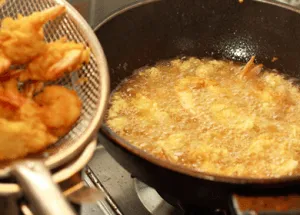What do deep-fried zucchini, salmon sauteed in butter, and garden pasta with Alfredo sauce have in common? They’re examples of how you can take a perfectly delicious, healthful food and weigh it down calorically with an unfortunate preparation style.

Just take a look at that deep-fried zucchini. Zucchini is a green vegetable, packed with vitamin C, potassium, fiber, and antioxidants–all for less than 20 calories per cup. By the time it’s battered and dunked in oil, the calories skyrocket to over 300, and there may not be very much heat-sensitive vitamin C left in it, either.
Whether you’re shopping for prepared foods, dining out or cooking at home, the most wholesome ingredients–lean poultry, fish, whole grains, vegetables, legumes, fruits, and nuts–can lose their luster if you prepare them with loads of butter, cream, oil, and salt.
FOOD PREP PITFALLS
Stay clear of these food preparation styles, which can detract from even the healthiest foods.
1. Deep-fried. Whether you’re munching chicken, fish, or Mozzarella, if you see “fried,” “crispy” or “breaded” on the description, chances are it’s deep-fried. “Any fried food, whether from a restaurant or home, is loaded with calories, and high cooking temperatures can destroy some nutrients,” says Frechman.
2. Pan-fry. There’s nothing wrong with a splash of olive oil to pan-fry or saute spinach or shrimp, but many restaurants–and home cooks–really glug on the oil, adding 120 calories with each tablespoon.
3. Buttered. Watch out for “butter” on the menu or on food labels of entrees, corn on the cob, crackers, or cookies; this artery-clogging ingredient contains 100 calories per tablespoon.
4. Salted. From salted nuts and pretzels to cured, salty meats, those tiny crystals of salt can really add up and push you over your daily sodium limit of 2,300 milligrams (mg) per day (even less if you’re at risk for high blood pressure).
5. Grilled. Sure, grilling is a lean, delicious method of cooking meats, but watch out for over-grilling or charring, which can form potential carcinogens in animal proteins. However, there’s no risk in grilled veggies, says Frechman.
6. Dressed. Salad dressings can toss hundreds of unwanted calories into your perfectly innocent mixture of vegetables. Creamy salad dressings can contain up to 170 calories and 3 grams (g) of saturated fat per ounce and vinaigrettes can pack up to 150 calories and 2 g of saturated fat per ounce. Just do the math if you slather a three-ounce portion over your salad.
7. Sauced. Watch out for decadent sauces and toppings that come with pasta, poultry, meat, or side dishes. For example, Alfredo sauce can add more than 400 calories to your dish.
8. Dipped. Think twice about those condiments you dip your sandwiches, chicken and sushi into. Soy sauce adds 900 mg of sodium per tablespoon, barbeque sauce can pack in up to 120 calories and 460 mg of sodium per ounce, and honey-mustard sauce can add 140 calories, 2 g saturated fat, and 320 mg of sodium per ounce.
TOP HEALTHY FOOD PREP STYLES
To make the most of your wholesome food ingredients, try our healthy food prep styles:
1. Don’t toss the salad. Instead, serve a small amount of light or oil-based dressing on the side. “Put the salad on your fork and then ‘dip’ it into a small amount of the salad dressing,” suggests Frechman.
2. Quickly sauteing veggies or lean meats, poultry or fish in a small amount of olive oil is a great preparation technique. Just measure out no more than one tablespoon for an entire family-sized meal.
3. The fresher, the better. The best way to preserve all of those nutrients in foods is to serve them fresh, such as in a salad or veggie appetizer.
4. Don’t toss out the peel. Remember, most of the nutrients in plant foods are found in the skin or directly under the skin. Don’t peel your fruits and veggies with edible skins, such as potatoes, carrots, cucumbers, apples and pears.
5. Crisp steaming. Don’t overcook vegetables in large amounts of water, which can leach nutrients. Steam them until they are crisp-tender.
6. Slow cooking. Pull out your crock pot to cook meats in slow, moist heat–a cooking style that doesn’t promote the development of carcinogens. It’s also great for cooking beans and lentils.
7. Try a rice cooker. The best way to cook whole grains, such as brown rice, wheat berries, barley and quinoa is to place the grain and the recommended amount of water into a rice cooker and push the button.
8. Bake it. Place chicken, fish, potatoes, and casseroles in the oven for an easy, light cooking technique.
9. Skip the sauce. Instead of relying on fatty, salty sauces, dips and condiments, serve “clean” whole foods with plenty of herbs, spices, tomato sauce, and lemon juice for flavor.
– Sharon Palmer R.D.
As a registered dietitian with 16 years of health care experience, she focuses on writing features covering health, wellness, nutrition, cooking, wine, restaurant reviews, and entertainment. Over 750 of Sharon’s features have been published in a variety of publications. Her recent book The Plant-Powered Diet: The Lifelong Eating Plan for Achieving Optimal Health, Beginning Today can be ordered here.

